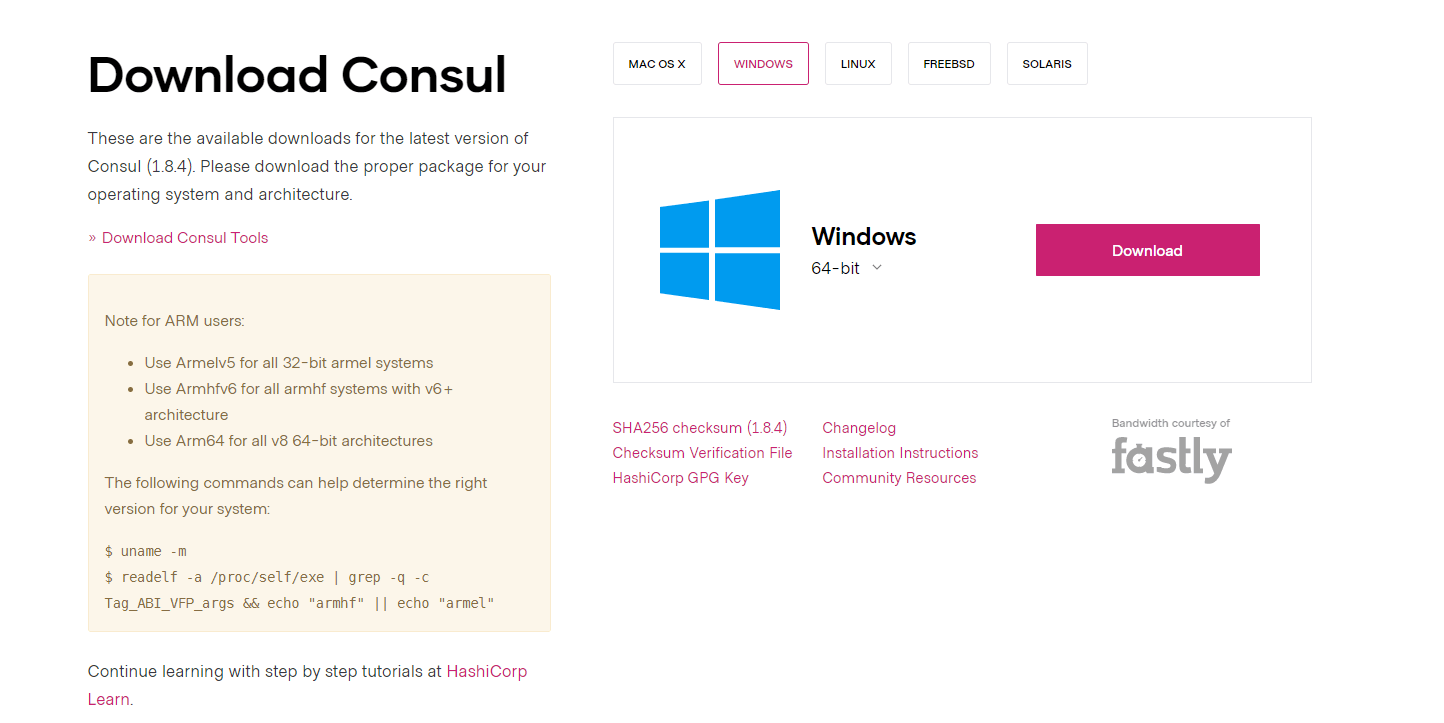1 Eureka闭源的影响
1.1 Eureka闭源
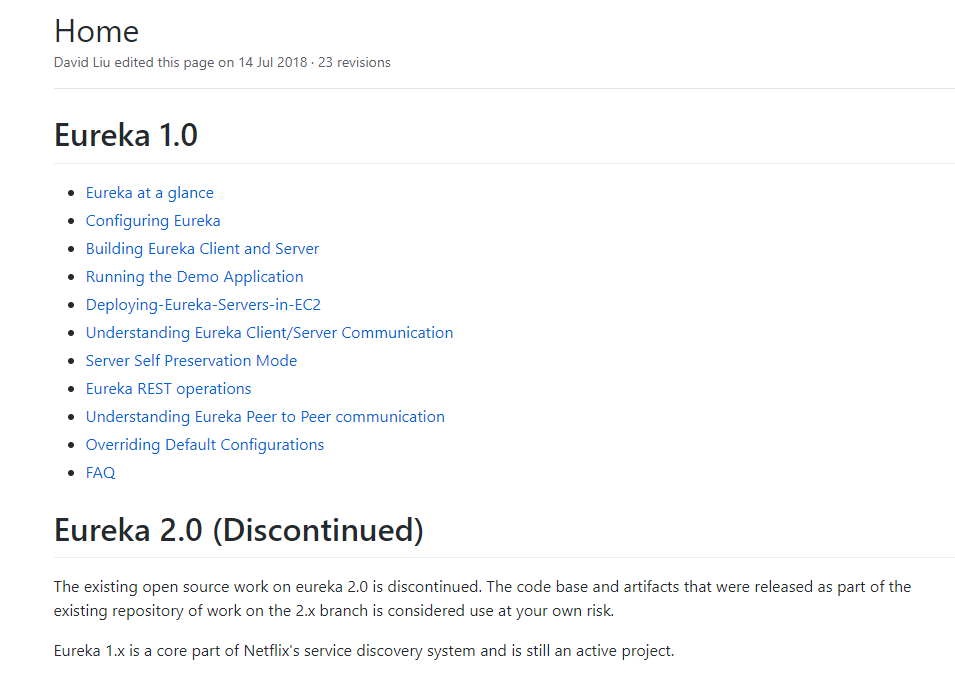
- 在Eureka的GitHub上,宣布Eureka 2.x闭源。这意味着如果开发者继续使用2.x分支上现有工作repo的一部分发布的代码库和组件,则自负风险。
1.2 Eureka的替换方案
1.2.1 Zookeeper
- Zookeeper是一个分布式的,开放源代码的分布式应用程序协调服务,是Hadoop和Hbase的重要组件。它是一个为分布式应用提供一致性服务的软件,提供的功能包括:配置维护、域名服务、分布式同步、组服务等。
1.2.2 Consul
- Consul是近几年比较流行的服务发现工具。
- Consul的三个主要应用场景:服务发现、服务隔离、服务配置。
1.2.3 Nacos
- Nacos是阿里巴巴推出来的一个新开源项目,这是一个更易于构建云原生应用的动态服务发现、配置管理和服务管理平台。Nacos致力于帮助您发现、配置和管理微服务。Nacos提供了一组简单易用的特性集,帮助您快速实现动态服务发现、服务配置、服务元数据以及流量管理。Nacos帮助您更敏捷和容易的构建、交付和管理微服务平台。Nacos是构建以“服务”为中心的现代应用架构(例如微服务范式、云原生范式)的服务基础设施。
2 Consul简介
2.1 概述
- Consul是HashiCorp公司推出的开源工具,用于实现分布式系统的服务发现和配置。和其他分布式服务注册和发现的方案,Consul的方案更“一站式”,内置了服务注册和发现框架、分布式一致性协议实现、健康检查、key/value存储、多数据中心方案,不再需要依赖其他工具(比如Zookeeper等)。使用起来也比较简单。Consul使用Go语言编写,因此具有天然移植性(支持Linux、Windows和Mac OS X),安装包仅包含一个可执行的文件,方便部署,和Docker等轻量级容器可以无缝配合。
2.2 Consul的优势
- 采用Raft算法来保证一致性,比服务的Paxos算法更直接。Zookeeper采用的是Paxos算法,而Consul以及etcd采用的是Raft算法。
- 支持多数据中心,内外网的服务采用不同的端口进行监听。多数据中心集群可以避免单数据中心的单点故障,而其部署则需要考虑网络延迟、分片等情况。Zookeeper和etcd均不提供多数据中心功能的支持。
- 支持健康检查。etcd不提供此功能。
- 支持http和dns协议接口。Zookeeper的集成较为复杂,etcd只支持http协议。
- 官方提供web管理界面。etcd无此功能。
2.3 Consul的特性
- 服务发现。
- 健康检查。
- key/value存储。
- 多数据中心。
2.4 Consul和Eureka的区别
2.4.1 一致性
- Consul:强一致性(CP):
服务注册相比Eureka会稍慢一些。因为Consul的Raft协议要求必须过半的节点都写入成功才认为注册成功。
Leader挂掉后,重新选举期间整个Consul不可用。保证了强一致性,但牺牲了可用性。
- Eureka:高可用性和最终一致性(AP):
服务注册相对要快,因为不需要等注册信息复制到其他节点,也不保证注册信息是否复制成功。
当数据出现不一致的时候,虽然A,B上的注册信息不完全相同,但是每个Eureka节点依然能够正常对外提供服务,这会出现查询服务信息时如果请求A查不到,但请求B就能查到。如果保证了可用性但牺牲了一致性。
2.4.2 开发语言和使用
- Eureka是Servlet程序,跑在Servlet容器中。
- Consul是Go语言编写而言的,安装启动即可。
2.5 Consul的下载和安装
Consul不同于Eureka需要单独安装,访问官网可以下载Consul的最新版本,目前使用的是Consul 1.8.4。根据不同的操作系统类型选择不同的安装包,Consul支持所有主流操作系统。
2.5.1 在linux中下载Consul
# 从官网下载最新版本的consul服务wget https://releases.hashicorp.com/consul/1.8.4/consul_1.8.4_linux_amd64.zip# 使用unzip命令解压unzip consul_1.8.4_linux_amd64.zip# 将解压好的consul可执行命令赋值到/usr/local/bin目录下cp consul /usr/local/bin# 测试一下consul
2.5.2 启动Consul
# 以开发者模式快速启动,-client指定客户端可以访问的IP地址consul agent -dev -client=0.0.0.0
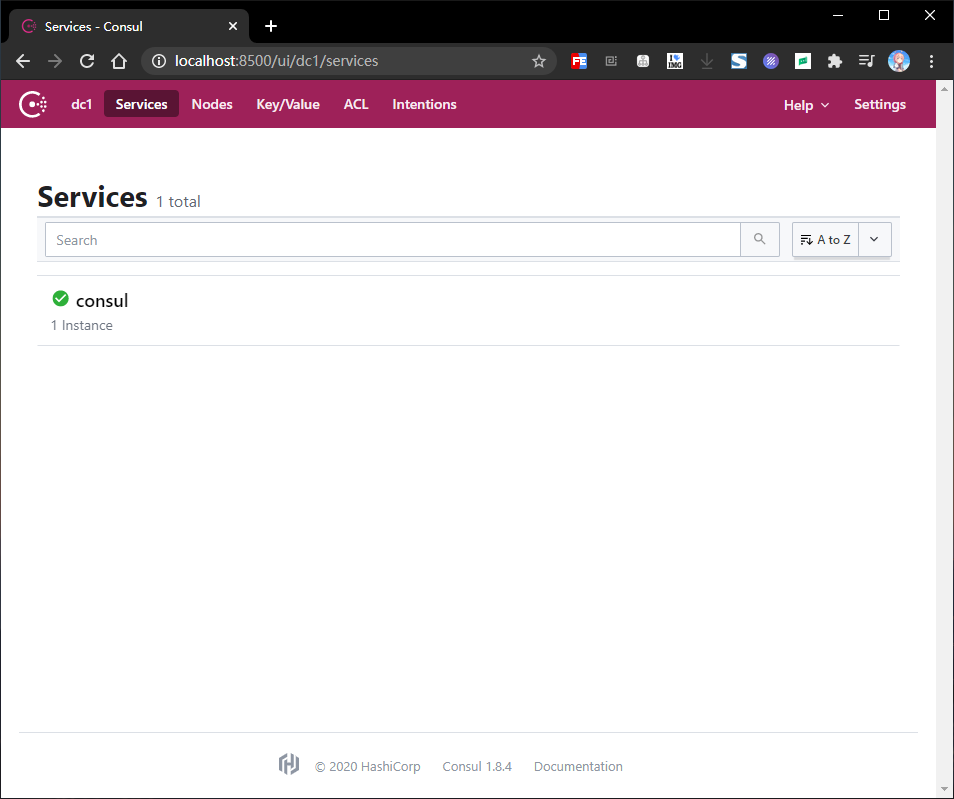
3 Consul的基本使用
Consul支持健康检查,并提供了HTTP和DNS调用的API接口来完成服务的注册,服务发现以及KV存储这些功能。本人在VMWear中的Linux的IP地址是192.168.32.100。
3.1 服务注册和发现
3.1.1 注册服务
- 通过postman发送PUT请求到http://192.168.32.100:8500/v1/catalog/register地址可以完成服务注册。
{"Datacenter": "dc1","Node": "node01","Address": "192.168.1.57","Service": {"ID": "mysql-01","Service": "mysql","tags": ["master","v1"],"Address": "192.168.1.57","Port": 3306}}
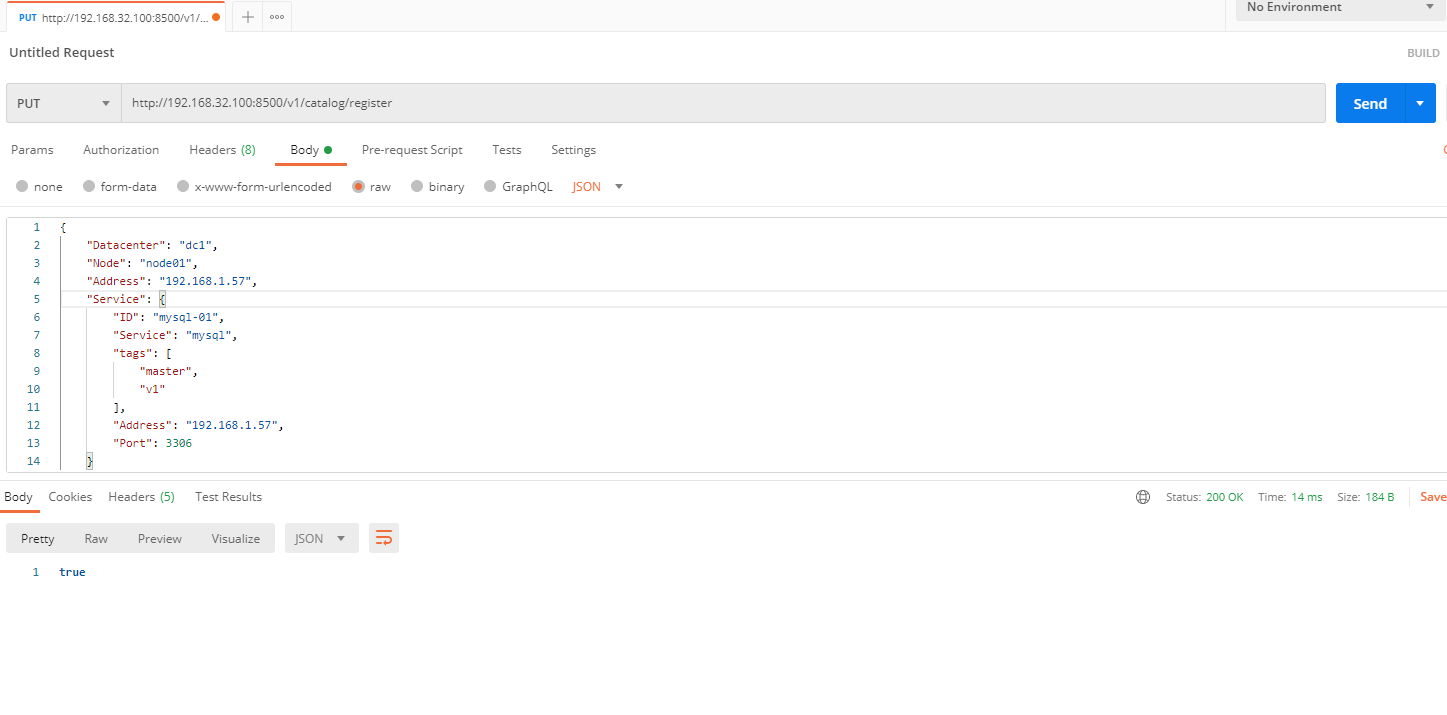
3.1.2 服务查询
- 通过postman发送GET请求到http://192.168.32.100:8500/v1/catalog/services地址获取所有的服务列表。
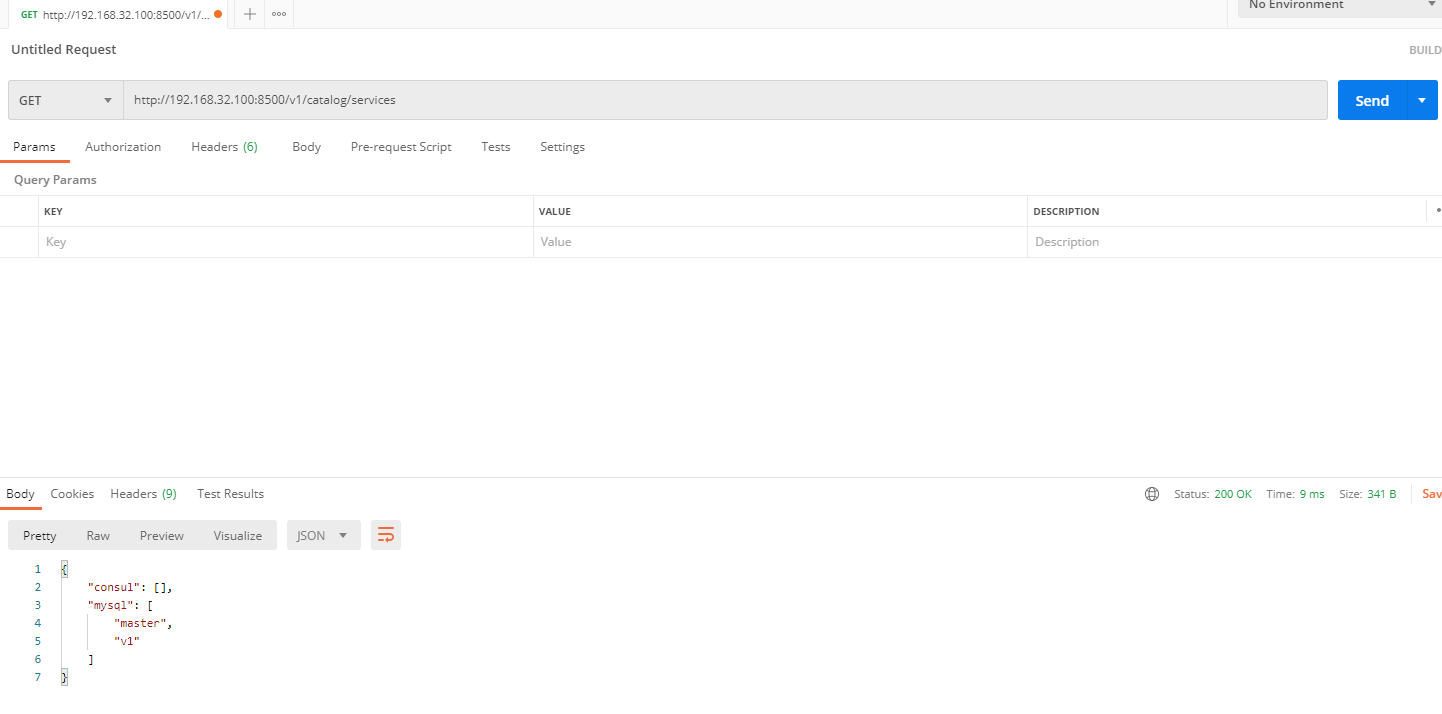
- 通过postman发送GET请求到http://192.168.32.100:8500/v1/catalog/service/mysql获取具体的服务。
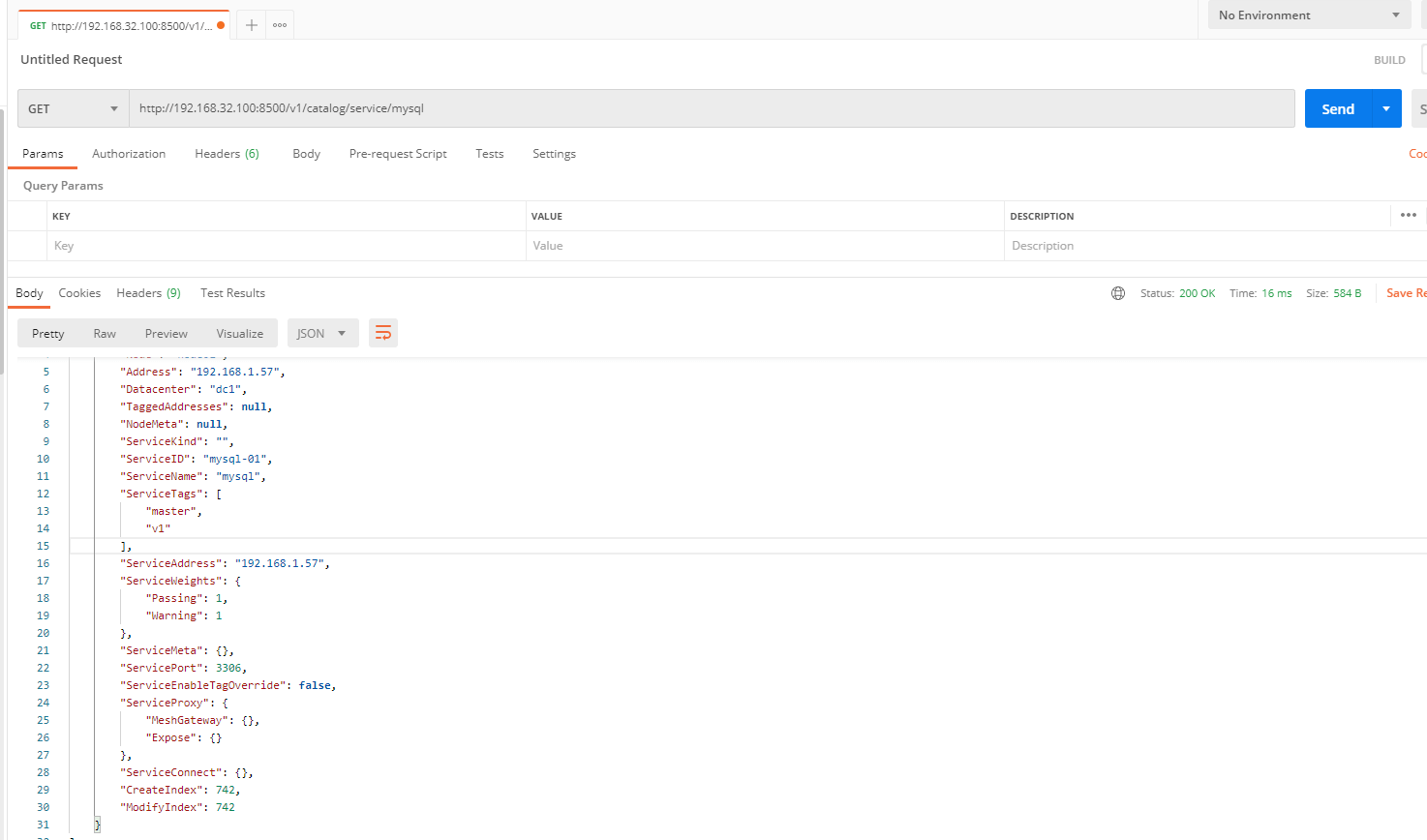
3.1.3 服务删除
- 通过postman发送PUT请求到http://192.168.32.100:8500/v1/catalog/deregister删除服务。
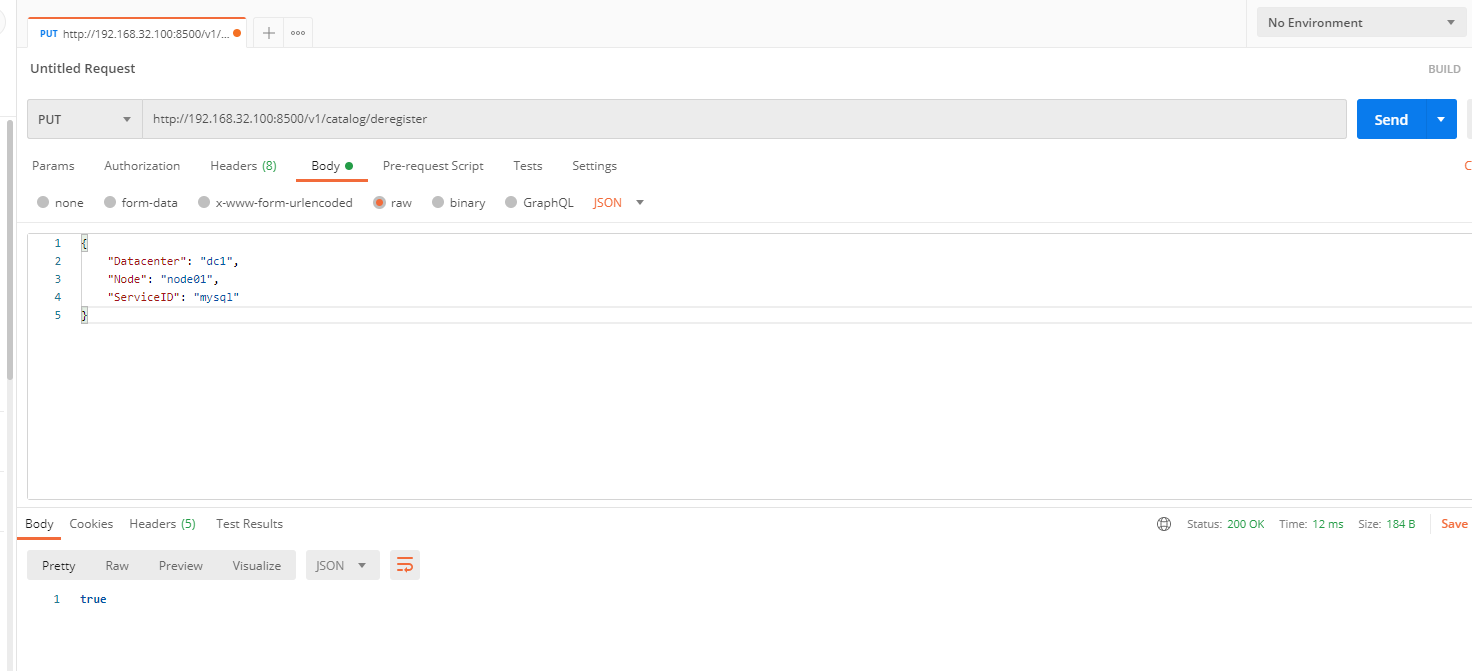
3.2 Consul的KV存储
- 可以参照Consul提供的KV存储的API完成基于Consul的数据存储。 | 含义 | 请求路径 | 请求方式 | | —- | —- | —- | | 查看key | v1/kv/:key | GET | | 保存或更新 | v1/kv/:key | put | | 删除 | /v1/kv/:key | DELETE |
- key值中可以带/,可以看做是不同的目录结构。
- value的值经过了base64编码,获取到数据后需要经过base64解码才能获取到原始值。数据不能大于521kb。
- 不同的数据中心的kv存储系统是独立的,使用dc=?参数指定。
4 基于Consul的服务注册
4.1 案例目标
- 准备一个商品微服务和订单微服务。
- 将商品微服务注册到Consul中。
- 订单微服务从consul中拉取所有的服务列表。
4.2 案例准备
4.2.1 sql脚本
SET NAMES utf8mb4;SET FOREIGN_KEY_CHECKS = 0;-- ------------------------------ Table structure for department-- ----------------------------DROP TABLE IF EXISTS `department`;CREATE TABLE `department` (`id` int(11) NOT NULL AUTO_INCREMENT,`name` varchar(255) CHARACTER SET utf8mb4 COLLATE utf8mb4_general_ci NULL DEFAULT NULL,PRIMARY KEY (`id`) USING BTREE) ENGINE = InnoDB AUTO_INCREMENT = 3 CHARACTER SET = utf8mb4 COLLATE = utf8mb4_general_ci ROW_FORMAT = Dynamic;-- ------------------------------ Records of department-- ----------------------------INSERT INTO `department` VALUES (1, '开发部');INSERT INTO `department` VALUES (2, '运维部');-- ------------------------------ Table structure for employee-- ----------------------------DROP TABLE IF EXISTS `employee`;CREATE TABLE `employee` (`id` int(11) NOT NULL AUTO_INCREMENT,`name` varchar(255) CHARACTER SET utf8mb4 COLLATE utf8mb4_general_ci NULL DEFAULT NULL,`gender` varchar(255) CHARACTER SET utf8mb4 COLLATE utf8mb4_general_ci NULL DEFAULT NULL,PRIMARY KEY (`id`) USING BTREE) ENGINE = InnoDB AUTO_INCREMENT = 3 CHARACTER SET = utf8mb4 COLLATE = utf8mb4_general_ci ROW_FORMAT = Dynamic;-- ------------------------------ Records of employee-- ----------------------------INSERT INTO `employee` VALUES (1, 'zhangsan', '男');INSERT INTO `employee` VALUES (2, '李四', '女');-- ------------------------------ Table structure for tb_order-- ----------------------------DROP TABLE IF EXISTS `tb_order`;CREATE TABLE `tb_order` (`id` bigint(11) NOT NULL AUTO_INCREMENT,`user_id` int(11) NULL DEFAULT NULL COMMENT '用户id',`product_id` int(11) NULL DEFAULT NULL COMMENT '商品id',`number` int(11) NULL DEFAULT NULL COMMENT '数量',`price` decimal(10, 2) NULL DEFAULT NULL COMMENT '单价',`amount` decimal(10, 2) NULL DEFAULT NULL COMMENT '总额',`product_name` varchar(40) CHARACTER SET utf8 COLLATE utf8_general_ci NULL DEFAULT NULL COMMENT '商品名',`username` varchar(40) CHARACTER SET utf8 COLLATE utf8_general_ci NULL DEFAULT NULL COMMENT '用户名',PRIMARY KEY (`id`) USING BTREE) ENGINE = InnoDB AUTO_INCREMENT = 1 CHARACTER SET = utf8 COLLATE = utf8_general_ci ROW_FORMAT = Dynamic;-- ------------------------------ Table structure for tb_product-- ----------------------------DROP TABLE IF EXISTS `tb_product`;CREATE TABLE `tb_product` (`id` bigint(20) NOT NULL AUTO_INCREMENT,`caption` varchar(255) CHARACTER SET utf8mb4 COLLATE utf8mb4_general_ci NULL DEFAULT NULL,`inventory` varchar(255) CHARACTER SET utf8mb4 COLLATE utf8mb4_general_ci NULL DEFAULT NULL,`price` decimal(19, 2) NULL DEFAULT NULL,`product_desc` varchar(255) CHARACTER SET utf8mb4 COLLATE utf8mb4_general_ci NULL DEFAULT NULL,`product_name` varchar(255) CHARACTER SET utf8mb4 COLLATE utf8mb4_general_ci NULL DEFAULT NULL,`status` int(11) NULL DEFAULT NULL,PRIMARY KEY (`id`) USING BTREE) ENGINE = MyISAM AUTO_INCREMENT = 2 CHARACTER SET = utf8mb4 COLLATE = utf8mb4_general_ci ROW_FORMAT = Dynamic;-- ------------------------------ Records of tb_product-- ----------------------------INSERT INTO `tb_product` VALUES (1, 'iPhone', '1', 5000.10, '苹果手机就是香', '苹果哇', 50);-- ------------------------------ Table structure for tb_user-- ----------------------------DROP TABLE IF EXISTS `tb_user`;CREATE TABLE `tb_user` (`id` bigint(11) NOT NULL AUTO_INCREMENT,`username` varchar(40) CHARACTER SET utf8 COLLATE utf8_general_ci NULL DEFAULT NULL COMMENT '用户名',`password` varchar(40) CHARACTER SET utf8 COLLATE utf8_general_ci NULL DEFAULT NULL COMMENT '密码',`age` int(3) NULL DEFAULT NULL COMMENT '年龄',`balance` decimal(10, 2) NULL DEFAULT NULL COMMENT '余额',`address` varchar(80) CHARACTER SET utf8 COLLATE utf8_general_ci NULL DEFAULT NULL COMMENT '地址',PRIMARY KEY (`id`) USING BTREE) ENGINE = InnoDB AUTO_INCREMENT = 1 CHARACTER SET = utf8 COLLATE = utf8_general_ci ROW_FORMAT = Dynamic;SET FOREIGN_KEY_CHECKS = 1;
4.2.2 商品微服务
- pom.xml
<?xml version="1.0" encoding="UTF-8"?><project xmlns="http://maven.apache.org/POM/4.0.0"xmlns:xsi="http://www.w3.org/2001/XMLSchema-instance"xsi:schemaLocation="http://maven.apache.org/POM/4.0.0 http://maven.apache.org/xsd/maven-4.0.0.xsd"><parent><artifactId>spring_cloud_demo</artifactId><groupId>org.sunxiaping</groupId><version>1.0</version></parent><modelVersion>4.0.0</modelVersion><artifactId>product_serivce-consul9003</artifactId><dependencies><!-- 服务监控 --><dependency><groupId>org.springframework.boot</groupId><artifactId>spring-boot-starter-actuator</artifactId></dependency><dependency><groupId>org.springframework.boot</groupId><artifactId>spring-boot-starter-data-jpa</artifactId></dependency><dependency><groupId>mysql</groupId><artifactId>mysql-connector-java</artifactId></dependency></dependencies></project>
- application.yml
server:port: 9003 # 微服务的端口号spring:application:name: service-product # 微服务的名称datasource:url: jdbc:mysql://192.168.1.57:3306/test?useUnicode=true&characterEncoding=UTF-8&autoReconnect=true&useSSL=false&serverTimezone=GMT%2B8&allowPublicKeyRetrieval=truedriver-class-name: com.mysql.cj.jdbc.Driverusername: rootpassword: 123456jpa:generate-ddl: trueshow-sql: trueopen-in-view: truedatabase: mysql# 微服务info内容详细信息info:app.name: xxxcompany.name: xxxbuild.artifactId: $project.artifactId$build.version: $project.version$
- Product.java
package com.sunxiaping.product.domain;import lombok.AllArgsConstructor;import lombok.Getter;import lombok.NoArgsConstructor;import lombok.Setter;import javax.persistence.*;import java.io.Serializable;import java.math.BigDecimal;@Setter@Getter@AllArgsConstructor@NoArgsConstructor@Entity@Table(name = "tb_product")public class Product implements Serializable {@Id@GeneratedValue(strategy = GenerationType.IDENTITY)private Long id;@Column(name = "product_name")private String productName;@Column(name = "status")private Integer status;@Column(name = "price")private BigDecimal price;@Column(name = "product_desc")private String productDesc;@Column(name = "caption")private String caption;@Column(name = "inventory")private String inventory;}
- ProductRepository.java
package com.sunxiaping.product.dao;import com.sunxiaping.product.domain.Product;import org.springframework.data.jpa.repository.JpaRepository;import org.springframework.data.jpa.repository.JpaSpecificationExecutor;import org.springframework.stereotype.Repository;@Repositorypublic interface ProductRepository extends JpaRepository<Product, Long>, JpaSpecificationExecutor<Product> {}
- ProductService.java
package com.sunxiaping.product.service;import com.sunxiaping.product.domain.Product;public interface ProductService {/*** 根据id查询** @param id* @return*/Product findById(Long id);/*** 保存** @param product*/void save(Product product);/*** 更新** @param product*/void update(Product product);/*** 删除** @param id*/void delete(Long id);}
- ProductServiceImpl.java
package com.sunxiaping.product.service.impl;import com.sunxiaping.product.dao.ProductRepository;import com.sunxiaping.product.domain.Product;import com.sunxiaping.product.service.ProductService;import org.springframework.beans.factory.annotation.Autowired;import org.springframework.stereotype.Service;import javax.transaction.Transactional;@Service@Transactionalpublic class ProductServiceImpl implements ProductService {@Autowiredprivate ProductRepository productRepository;@Overridepublic Product findById(Long id) {return productRepository.findById(id).orElse(new Product());}@Overridepublic void save(Product product) {productRepository.save(product);}@Overridepublic void update(Product product) {productRepository.save(product);}@Overridepublic void delete(Long id) {productRepository.deleteById(id);}}
- ProductController.java
package com.sunxiaping.product.controller;import com.sunxiaping.product.domain.Product;import com.sunxiaping.product.service.ProductService;import org.springframework.beans.factory.annotation.Autowired;import org.springframework.web.bind.annotation.*;@RestController@RequestMapping(value = "/product")public class ProductController {@Autowiredprivate ProductService productService;@PostMapping(value = "/save")public String save(@RequestBody Product product) {productService.save(product);return "新增成功";}@GetMapping(value = "/findById/{id}")public Product findById(@PathVariable(value = "id") Long id) {Product product = productService.findById(id);return product;}}
- 启动类:
package com.sunxiaping.product;import org.springframework.boot.SpringApplication;import org.springframework.boot.autoconfigure.SpringBootApplication;@SpringBootApplicationpublic class Product9003Application {public static void main(String[] args) {SpringApplication.run(Product9003Application.class, args);}}
4.2.3 订单微服务
- pom.xml
<?xml version="1.0" encoding="UTF-8"?><project xmlns="http://maven.apache.org/POM/4.0.0"xmlns:xsi="http://www.w3.org/2001/XMLSchema-instance"xsi:schemaLocation="http://maven.apache.org/POM/4.0.0 http://maven.apache.org/xsd/maven-4.0.0.xsd"><parent><artifactId>spring_cloud_demo</artifactId><groupId>org.sunxiaping</groupId><version>1.0</version></parent><modelVersion>4.0.0</modelVersion><artifactId>order-service-consul9004</artifactId><dependencies><dependency><groupId>org.springframework.boot</groupId><artifactId>spring-boot-starter-data-jpa</artifactId></dependency><dependency><groupId>mysql</groupId><artifactId>mysql-connector-java</artifactId></dependency></dependencies></project>
- application.yml
server:port: 9004 # 微服务的端口号spring:application:name: service-order # 微服务的名称datasource:url: jdbc:mysql://192.168.1.57:3306/test?useUnicode=true&characterEncoding=UTF-8&autoReconnect=true&useSSL=false&serverTimezone=GMT%2B8&allowPublicKeyRetrieval=truedriver-class-name: com.mysql.cj.jdbc.Driverusername: rootpassword: 123456jpa:generate-ddl: trueshow-sql: trueopen-in-view: truedatabase: mysqljmx:unique-names: true# 微服务info内容详细信息info:app.name: xxxcompany.name: xxxbuild.artifactId: $project.artifactId$build.version: $project.version$# 开启日志debuglogging:level:root: info
- SpringConfig.java
package com.sunxiaping.order.config;import org.springframework.context.annotation.Bean;import org.springframework.context.annotation.Configuration;import org.springframework.web.client.RestTemplate;@Configurationpublic class SpringConfig {@Beanpublic RestTemplate restTemplate() {return new RestTemplate();}}
- Product.java
package com.sunxiaping.order.domain;import lombok.AllArgsConstructor;import lombok.Getter;import lombok.NoArgsConstructor;import lombok.Setter;import javax.persistence.*;import java.io.Serializable;import java.math.BigDecimal;@Setter@Getter@AllArgsConstructor@NoArgsConstructor@Entity@Table(name = "tb_product")public class Product implements Serializable {@Id@GeneratedValue(strategy = GenerationType.IDENTITY)private Long id;@Column(name = "product_name")private String productName;@Column(name = "status")private Integer status;@Column(name = "price")private BigDecimal price;@Column(name = "product_desc")private String productDesc;@Column(name = "caption")private String caption;@Column(name = "inventory")private String inventory;}
- OrderController.java
package com.sunxiaping.order.controller;import com.sunxiaping.order.domain.Product;import org.springframework.beans.factory.annotation.Autowired;import org.springframework.web.bind.annotation.GetMapping;import org.springframework.web.bind.annotation.PathVariable;import org.springframework.web.bind.annotation.RequestMapping;import org.springframework.web.bind.annotation.RestController;import org.springframework.web.client.RestTemplate;@RestController@RequestMapping(value = "/order")public class OrderController {@Autowiredprivate RestTemplate restTemplate;@GetMapping(value = "/buy/{id}")public Product buy(@PathVariable(value = "id") Long id) {Product product = restTemplate.getForObject("http://localhost:9003/product/findById/" + id, Product.class);return product;}}
- 启动类:
package com.sunxiaping.order;import org.springframework.boot.SpringApplication;import org.springframework.boot.autoconfigure.SpringBootApplication;@SpringBootApplicationpublic class Order9004Application {public static void main(String[] args) {SpringApplication.run(Order9004Application.class, args);}}
4.3 服务注册
4.3.1 在商品微服务中添加SpringCloud基于Consul的依赖
- 修改部分:
<!-- SpringCloud提供的基于Consul的服务发现 --><dependency><groupId>org.springframework.cloud</groupId><artifactId>spring-cloud-starter-consul-discovery</artifactId></dependency>
- 完整部分:
<?xml version="1.0" encoding="UTF-8"?><project xmlns="http://maven.apache.org/POM/4.0.0"xmlns:xsi="http://www.w3.org/2001/XMLSchema-instance"xsi:schemaLocation="http://maven.apache.org/POM/4.0.0 http://maven.apache.org/xsd/maven-4.0.0.xsd"><parent><artifactId>spring_cloud_demo</artifactId><groupId>org.sunxiaping</groupId><version>1.0</version></parent><modelVersion>4.0.0</modelVersion><artifactId>product_serivce-consul9003</artifactId><dependencies><!-- 服务监控 --><dependency><groupId>org.springframework.boot</groupId><artifactId>spring-boot-starter-actuator</artifactId></dependency><!-- SpringCloud提供的基于Consul的服务发现 --><dependency><groupId>org.springframework.cloud</groupId><artifactId>spring-cloud-starter-consul-discovery</artifactId></dependency><dependency><groupId>org.springframework.boot</groupId><artifactId>spring-boot-starter-data-jpa</artifactId></dependency><dependency><groupId>mysql</groupId><artifactId>mysql-connector-java</artifactId></dependency></dependencies></project>
4.3.2 在商品微服务的application.yml中配置服务注册
- 修改部分:
spring:# 开始配置Consul的服务注册cloud:consul:# ConsulServer的主机地址host: 192.168.32.100# ConsulServer端口port: 8500discovery:# 是否注册register: true# 服务实例id 必须填写 也可以写成 {spring.application.name}:${spring.cloud.client.ip-address}instance-id: ${spring.application.name}-1# 服务实例名称service-name: ${spring.application.name}# 服务实例端口port: ${server.port}# 健康检查路径health-check-path: /actuator/health# 健康检查时间间隔health-check-interval: 15s# 开启IP注册prefer-ip-address: true# 实例的请求IPip-address: ${spring.cloud.client.ip-address}
- 完整部分:
server:port: 9003 # 微服务的端口号spring:application:name: service-product # 微服务的名称datasource:url: jdbc:mysql://192.168.1.57:3306/test?useUnicode=true&characterEncoding=UTF-8&autoReconnect=true&useSSL=false&serverTimezone=GMT%2B8&allowPublicKeyRetrieval=truedriver-class-name: com.mysql.cj.jdbc.Driverusername: rootpassword: 123456jpa:generate-ddl: trueshow-sql: trueopen-in-view: truedatabase: mysql# 开始配置Consul的服务注册cloud:consul:# ConsulServer的主机地址host: 192.168.32.100# ConsulServer端口port: 8500discovery:# 是否注册register: true# 服务实例id 必须填写 也可以写成 {spring.application.name}:${spring.cloud.client.ip-address}instance-id: ${spring.application.name}-1# 服务实例名称service-name: ${spring.application.name}# 服务实例端口port: ${server.port}# 健康检查路径health-check-path: /actuator/health# 健康检查时间间隔health-check-interval: 15s# 开启IP注册prefer-ip-address: true# 实例的请求IPip-address: ${spring.cloud.client.ip-address}# 微服务info内容详细信息info:app.name: xxxcompany.name: xxxbuild.artifactId: $project.artifactId$build.version: $project.version$
4.3.3 启动类上加上@EnableDiscoveryClient注解
- 启动类:
package com.sunxiaping.product;import org.springframework.boot.SpringApplication;import org.springframework.boot.autoconfigure.SpringBootApplication;import org.springframework.cloud.client.discovery.EnableDiscoveryClient;@SpringBootApplication@EnableDiscoveryClientpublic class Product9003Application {public static void main(String[] args) {SpringApplication.run(Product9003Application.class, args);}}
4.4 服务发现
4.4.1 在订单微服务中添加SpringCloud基于Consul的依赖
- 修改部分:
<!-- 服务监控 --><dependency><groupId>org.springframework.boot</groupId><artifactId>spring-boot-starter-actuator</artifactId></dependency><!-- SpringCloud提供的基于Consul的服务发现 --><dependency><groupId>org.springframework.cloud</groupId><artifactId>spring-cloud-starter-consul-discovery</artifactId></dependency>
- 完整部分:
<?xml version="1.0" encoding="UTF-8"?><project xmlns="http://maven.apache.org/POM/4.0.0"xmlns:xsi="http://www.w3.org/2001/XMLSchema-instance"xsi:schemaLocation="http://maven.apache.org/POM/4.0.0 http://maven.apache.org/xsd/maven-4.0.0.xsd"><parent><artifactId>spring_cloud_demo</artifactId><groupId>org.sunxiaping</groupId><version>1.0</version></parent><modelVersion>4.0.0</modelVersion><artifactId>order-service-consul9004</artifactId><dependencies><dependency><groupId>org.springframework.boot</groupId><artifactId>spring-boot-starter-data-jpa</artifactId></dependency><dependency><groupId>mysql</groupId><artifactId>mysql-connector-java</artifactId></dependency><!-- 服务监控 --><dependency><groupId>org.springframework.boot</groupId><artifactId>spring-boot-starter-actuator</artifactId></dependency><!-- SpringCloud提供的基于Consul的服务发现 --><dependency><groupId>org.springframework.cloud</groupId><artifactId>spring-cloud-starter-consul-discovery</artifactId></dependency></dependencies></project>
4.4.2 在订单微服务的application.yml中配置服务注册
- 修改部分:
spring:# 开始配置Consul的服务注册cloud:consul:# ConsulServer的主机地址host: 192.168.32.100# ConsulServer端口port: 8500discovery:# 是否注册register: true# 服务实例id 必须填写 也可以写成 {spring.application.name}:${spring.cloud.client.ip-address}instance-id: ${spring.application.name}-1# 服务实例名称service-name: ${spring.application.name}# 服务实例端口port: ${server.port}# 健康检查路径health-check-path: /actuator/health# 健康检查时间间隔health-check-interval: 15s# 开启IP注册prefer-ip-address: true# 实例的请求IPip-address: ${spring.cloud.client.ip-address}
- 完整部分:
server:port: 9004 # 微服务的端口号spring:application:name: service-order # 微服务的名称datasource:url: jdbc:mysql://192.168.1.57:3306/test?useUnicode=true&characterEncoding=UTF-8&autoReconnect=true&useSSL=false&serverTimezone=GMT%2B8&allowPublicKeyRetrieval=truedriver-class-name: com.mysql.cj.jdbc.Driverusername: rootpassword: 123456jpa:generate-ddl: trueshow-sql: trueopen-in-view: truedatabase: mysqljmx:unique-names: true# 开始配置Consul的服务注册cloud:consul:# ConsulServer的主机地址host: 192.168.32.100# ConsulServer端口port: 8500discovery:# 是否注册register: true# 服务实例id 必须填写 也可以写成 {spring.application.name}:${spring.cloud.client.ip-address}instance-id: ${spring.application.name}-1# 服务实例名称service-name: ${spring.application.name}# 服务实例端口port: ${server.port}# 健康检查路径health-check-path: /actuator/health# 健康检查时间间隔health-check-interval: 15s# 开启IP注册prefer-ip-address: true# 实例的请求IPip-address: ${spring.cloud.client.ip-address}# 微服务info内容详细信息info:app.name: xxxcompany.name: xxxbuild.artifactId: $project.artifactId$build.version: $project.version$# 开启日志debuglogging:level:root: info
4.4.3 在商品微服务的RestTemplate上面标注@LoadBalanced注解
- SpringConfig.java
package com.sunxiaping.order.config;import org.springframework.cloud.client.loadbalancer.LoadBalanced;import org.springframework.context.annotation.Bean;import org.springframework.context.annotation.Configuration;import org.springframework.web.client.RestTemplate;@Configurationpublic class SpringConfig {/*** SpringCloud对Consul进行了进一步的处理,向其中集成了Ribbon的支持** @return*/@LoadBalanced@Beanpublic RestTemplate restTemplate() {return new RestTemplate();}}
4.4.4 修改Controller
- OrderController.java
package com.sunxiaping.order.controller;import com.sunxiaping.order.domain.Product;import org.springframework.beans.factory.annotation.Autowired;import org.springframework.web.bind.annotation.GetMapping;import org.springframework.web.bind.annotation.PathVariable;import org.springframework.web.bind.annotation.RequestMapping;import org.springframework.web.bind.annotation.RestController;import org.springframework.web.client.RestTemplate;@RestController@RequestMapping(value = "/order")public class OrderController {@Autowiredprivate RestTemplate restTemplate;@GetMapping(value = "/buy/{id}")public Product buy(@PathVariable(value = "id") Long id) {Product product = restTemplate.getForObject("http://service-product/product/findById/" + id, Product.class);return product;}}
4.4.5 启动类上加@EnableDiscoveryClient注解
- 启动类:
package com.sunxiaping.order;import org.springframework.boot.SpringApplication;import org.springframework.boot.autoconfigure.SpringBootApplication;import org.springframework.cloud.client.discovery.EnableDiscoveryClient;@EnableDiscoveryClient@SpringBootApplicationpublic class Order9004Application {public static void main(String[] args) {SpringApplication.run(Order9004Application.class, args);}}
5 Consul集群的搭建
5.1 Consul的架构简介
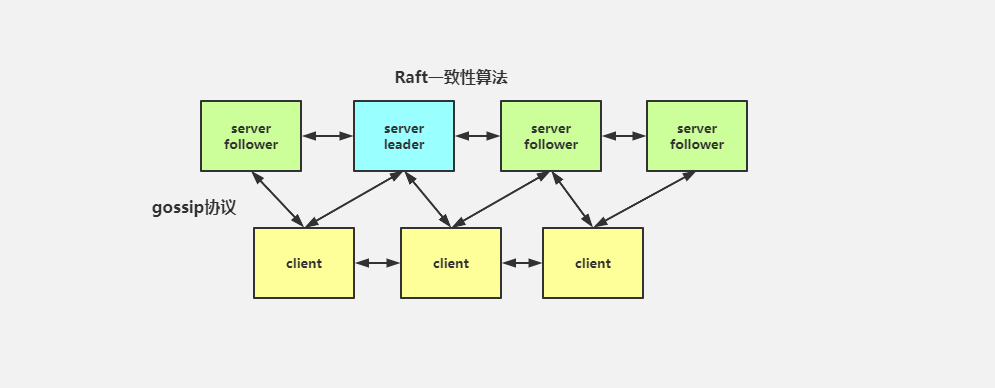
- 图中的Server是Consul服务端高可用集群,Client是Consul的客户端。Consul客户端不保存数据,客户端将接收到的请求转发给响应的Server端。Server之间通过局域网或广域网通信实现数据一致性。每个Server或Client都是一个Consul agent。Consul集群间使用了gossip协议和raft一致性算法。
- 上图涉及到的相关术语:
agent:agent是用来启动一个consul的守护进程。
client:是consul的代理,用来和consul server进行交互。一个微服务对应一个client,微服务和client部署到一台机器上。
server:一个server是一个具有一组扩展功能的代理,这些功能包括参与raft选举、维护集群状态、响应RPC查询,和其他数据中心交互以及转发查询给Leader或者远程数据中心等。简而言之。server就是真正干活的consul服务。一般推荐3~5个。
gossip协议:流言协议。所有的consul都会参与到gossip协议中。
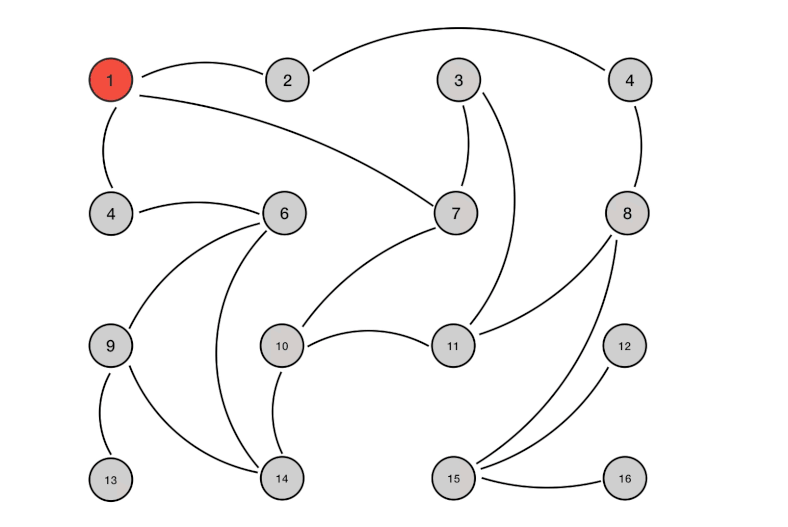
raft协议:保证server集群的数据一致。
- Leader:处理所有客户端交互、日志复制等,一般一次只有一个Leader。
- Follower:类似选民,完全被动。
- Candidate(候选人):可以被选为一个新的领导人。
- Leader全权负责所有客户端的请求,以及将数据同步到Follower中(同一时刻系统中只存在一个Leader)。
- Follower被动响应请求RPC,从不主动发起RPC。
- Candidate由Follower向Leader转换中间状态。
5.2 Consul集群搭建
5.2.1 概述
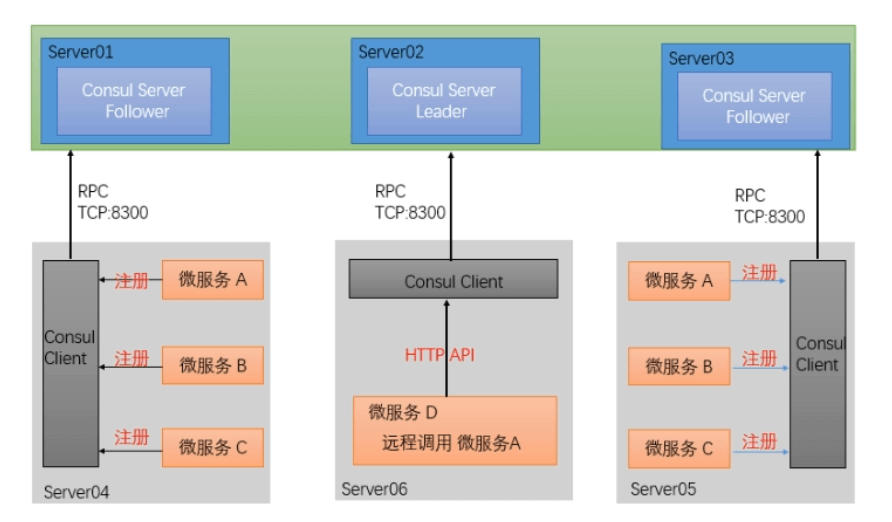
- 首先一个正常的Consul集群,有Server,有Client。这里的服务器Server1、Server2和Server3上分别部署了Consul Server(这些服务器上最好只部署Consul程序,以尽量维护Consul Server的稳定)。
- 服务器Server4和Server5上通过Consul Client分别注册Service A、B、C,这里每个Service分别注册在了两个服务器上,这样可以避免Service的单点问题(一般而言微服务和Client绑定)。
- 在服务器Server6中Service D需要访问ServiceB,这个时候Service D首先访问本机Consul Client提供的HTTP API,本机Client会将请求转发到Consul Server,Consul Server查询到Service B当前的信息返回。
5.2.2 准备环境
| 服务器IP | Consul类型 | Node节点名称 | 序号 |
|---|---|---|---|
| 192.168.237.100 | Server | server-1 | s1 |
| 192.168.237.101 | Server | server-2 | s2 |
| 192.168.237.102 | Server | server-3 | s3 |
| 192.168.237.1 | Client | client-1 | s4 |
简而言之,就是通过VMWear新建3个CentOS7环境,然后每个CentOS7环境中的网络模式都是NAT。
- agent以client模式启动的节点:在该模式下,该节点会采集相关信息,通过RPC的方式向server发送。client模式节点有无数个,官方建议搭配微服务配置。
- agent以server模式启动的节点:一个数据中心至少包含1个server节点。不过官网建议使用3~5个server节点组成集群,以保证高可用且不失效率。server节点参与raft、维护微服务信息、注册服务、健康检查等功能。
5.2.3 安装consul并启动
- 关闭每个consul节点上(Linux机器)上的防火墙:
systemctl stop firewalldsystemctl disable firewalld
- 在每个consul节点上安装consul服务,下载安装过程和单节点一致:
# 从官网下载最新版本的consul服务wget https://releases.hashicorp.com/consul/1.8.4/consul_1.8.4_linux_amd64.zip# 使用unzip命令解压unzip consul_1.8.4_linux_amd64.zip# 将解压好的consul可执行命令赋值到/usr/local/bin目录下cp consul /usr/local/bin# 测试一下consul
- 启动每个consul server节点:
consul agent -server -bootstrap-expect 3 -data-dir=/etc/consul.d -node=server-1 -bind=192.168.237.100 -ui -client 0.0.0.0 &
consul agent -server -bootstrap-expect 3 -data-dir=/etc/consul.d -node=server-2 -bind=192.168.237.101 -ui -client 0.0.0.0 &
consul agent -server -bootstrap-expect 3 -data-dir=/etc/consul.d -node=server-3 -bind=192.168.237.102 -ui -client 0.0.0.0 &
-server:以server身份启动 -bootstrap-expect:集群要求的最少Server数量,当低于这个数量,集群将失效 -data-dir:data存放的目录。 -node:节点id,在同一集群中不能重复。 -bind:监听的IP地址。 -client:客户端的IP地址(0.0.0.0)表示不限制。 &:在后台运行,Linux脚本语法
- 在本地电脑中使用client形式启动consul:
consul agent -data-dir /etc/consul.d -node=client-1 -bind=192.168.237.1 -client=0.0.0.0
5.2.4 每个节点加入到集群中
- 在s2(192.168.237.101),s3(192.168.237.102)和s4(192.168.237.1)服务行通过consul join命令加入s1中的consul集群中。
## 加入到consul集群consul join 192.168.237.100
5.2.5 测试
- 在任意一台服务器中输入consul members查看集群中的所有节点信息:
# 查看consul集群节点信息consul members

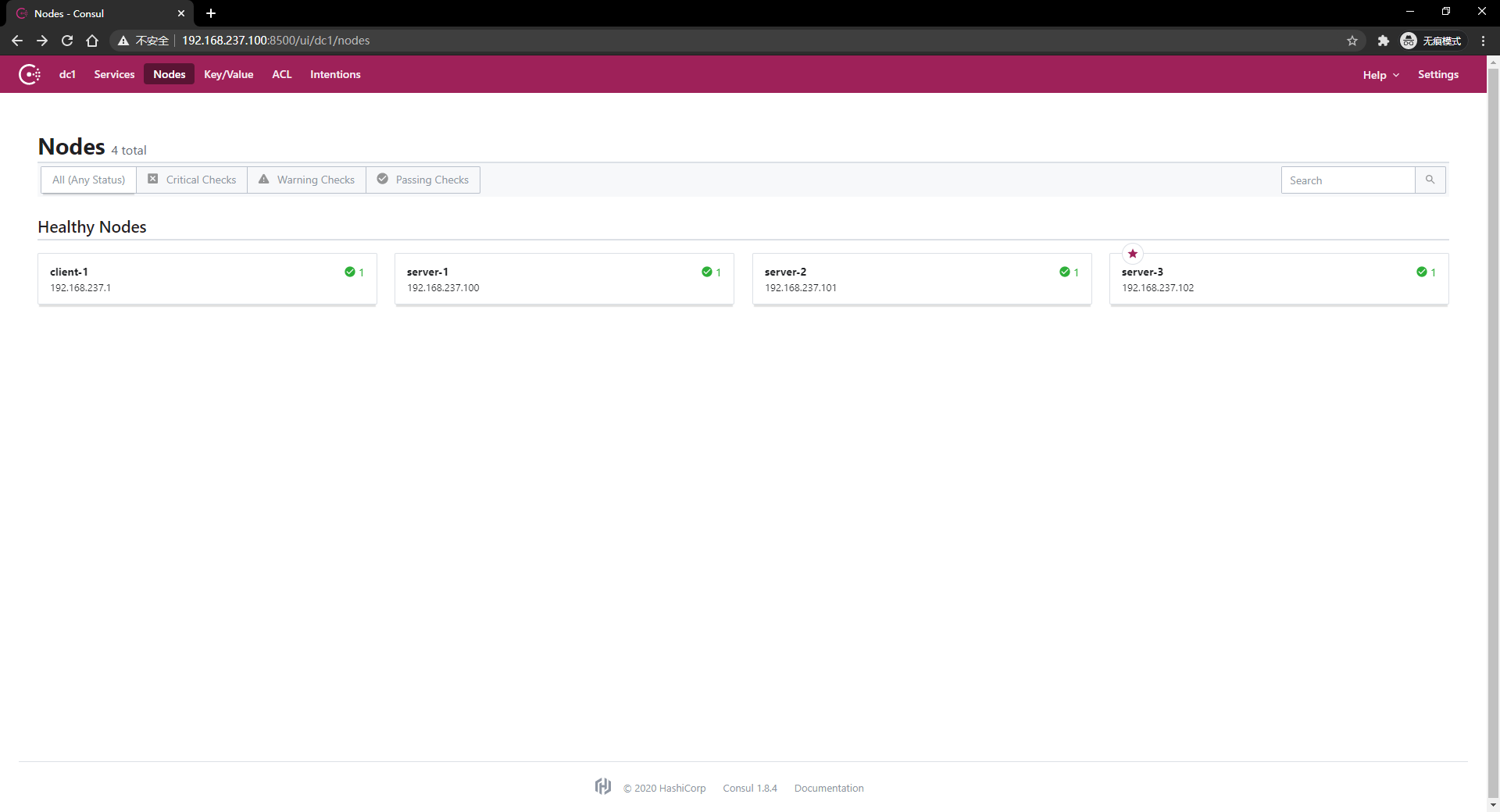
5.3 微服务注册到Consul集群中
5.3.1 订单微服务注册到Consul集群中
- application.yml
server:port: 9003 # 微服务的端口号spring:application:name: service-product # 微服务的名称datasource:url: jdbc:mysql://192.168.237.100:3306/test?useUnicode=true&characterEncoding=UTF-8&autoReconnect=true&useSSL=false&serverTimezone=GMT%2B8&allowPublicKeyRetrieval=truedriver-class-name: com.mysql.cj.jdbc.Driverusername: rootpassword: 123456jpa:generate-ddl: trueshow-sql: trueopen-in-view: truedatabase: mysql# 开始配置Consul的服务注册cloud:consul:# Consul Client的地址 修改的地方host: 192.168.237.1# ConsulServer端口port: 8500discovery:# 是否注册register: true# 服务实例id 必须填写 也可以写成 {spring.application.name}:${spring.cloud.client.ip-address}instance-id: ${spring.application.name}-1# 服务实例名称service-name: ${spring.application.name}# 服务实例端口port: ${server.port}# 健康检查路径health-check-path: /actuator/health# 健康检查时间间隔health-check-interval: 15s# 开启IP注册prefer-ip-address: true# 实例的请求IPip-address: ${spring.cloud.client.ip-address}# 微服务info内容详细信息info:app.name: xxxcompany.name: xxxbuild.artifactId: $project.artifactId$build.version: $project.version$
5.3.2 商品微服务注册到Consul集群中
- application.yml
server:port: 9004 # 微服务的端口号spring:application:name: service-order # 微服务的名称datasource:url: jdbc:mysql://192.168.237.100:3306/test?useUnicode=true&characterEncoding=UTF-8&autoReconnect=true&useSSL=false&serverTimezone=GMT%2B8&allowPublicKeyRetrieval=truedriver-class-name: com.mysql.cj.jdbc.Driverusername: rootpassword: 123456jpa:generate-ddl: trueshow-sql: trueopen-in-view: truedatabase: mysqljmx:unique-names: true# 开始配置Consul的服务注册cloud:consul:# Consul Client的地址 修改的地方host: 192.168.237.1# ConsulServer端口port: 8500discovery:# 是否注册register: true# 服务实例id 必须填写 也可以写成 {spring.application.name}:${spring.cloud.client.ip-address}instance-id: ${spring.application.name}-1# 服务实例名称service-name: ${spring.application.name}# 服务实例端口port: ${server.port}# 健康检查路径health-check-path: /actuator/health# 健康检查时间间隔health-check-interval: 15s# 开启IP注册prefer-ip-address: true# 实例的请求IPip-address: ${spring.cloud.client.ip-address}# 微服务info内容详细信息info:app.name: xxxcompany.name: xxxbuild.artifactId: $project.artifactId$build.version: $project.version$# 开启日志debuglogging:level:root: info
5.4 Consul的常见问题
5.4.1 节点和服务注销
- 当服务或者节点失效,Consul不会对注册的信息进行剔除处理,仅仅进行标记而已(并且服务不可以使用)。如果担心失效节点和失效服务过多影响监控。可以通过调用HTTP API的形式进行处理。
- 节注销任意节点和服务:
# PUT请求http://192.168.32.100:8500/v1/catalog/deregister
- 注销当前节点的服务:
# PUT请求http://192.168.32.100:8500/v1/agent/service/deregister/[service-id]
- 如果某个节点不继续使用,也可以在本机使用
consul leave命令,或者在其他节点使用consul force-level 节点id。
5.4.2 健康检查和故障转移
- 在集群环境下,健康检查是由服务注册到的agent来处理的,如果这个agent挂掉了,那么此节点的健康检查就处于无人管理的状态了。
- 从实际应用看,节点上的服务可能既要被发现,又要发现别的服务,如果节点挂掉了,仅提供被发现的功能实际上服务还是不可用的。当然发现别的服务也可以不使用本机节点,可以通过访问一个Nginx实现的若干Consul节点的负载均衡来实现。
